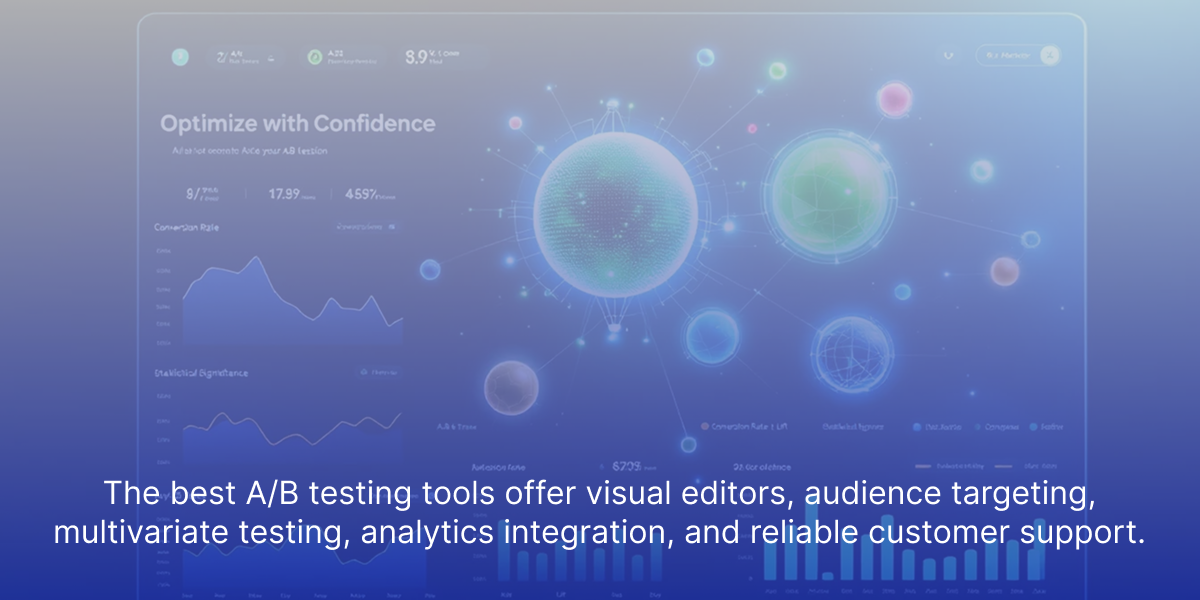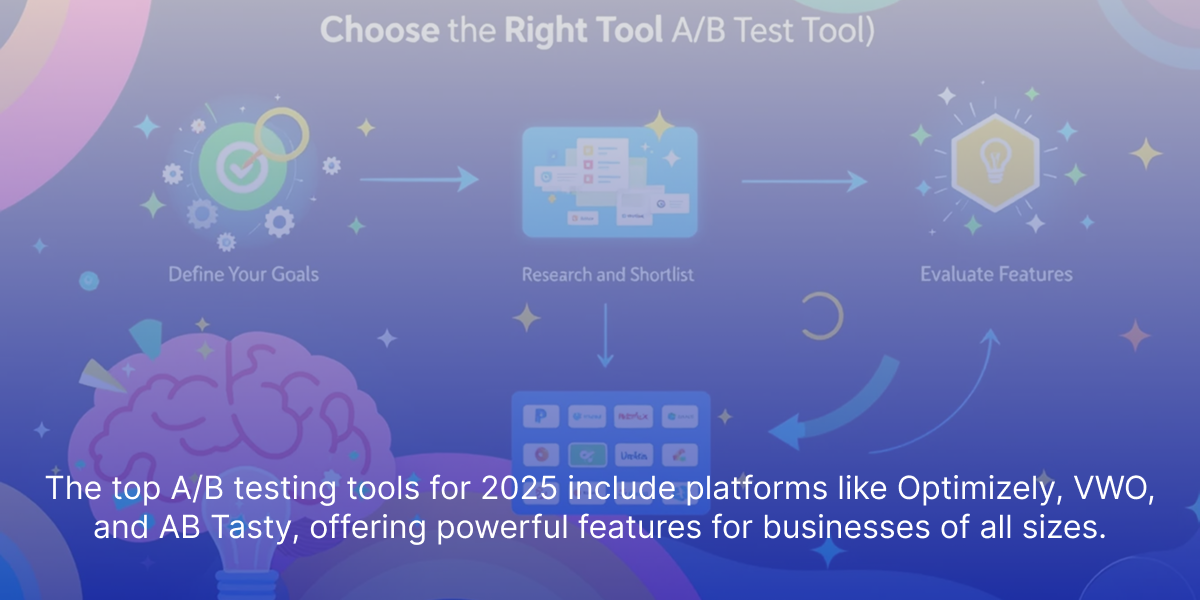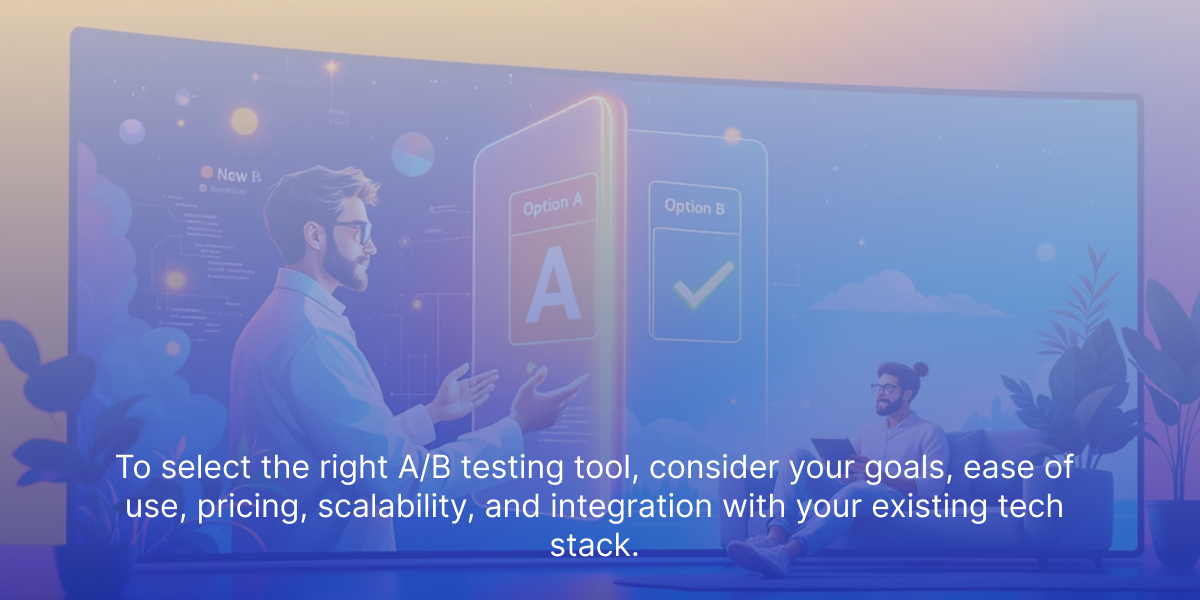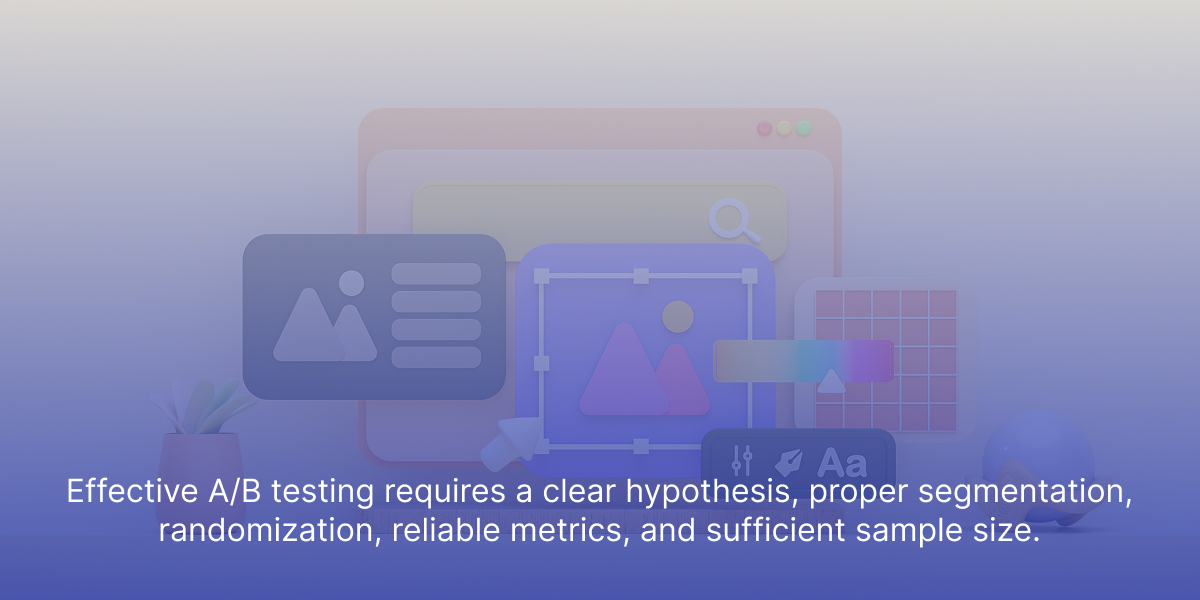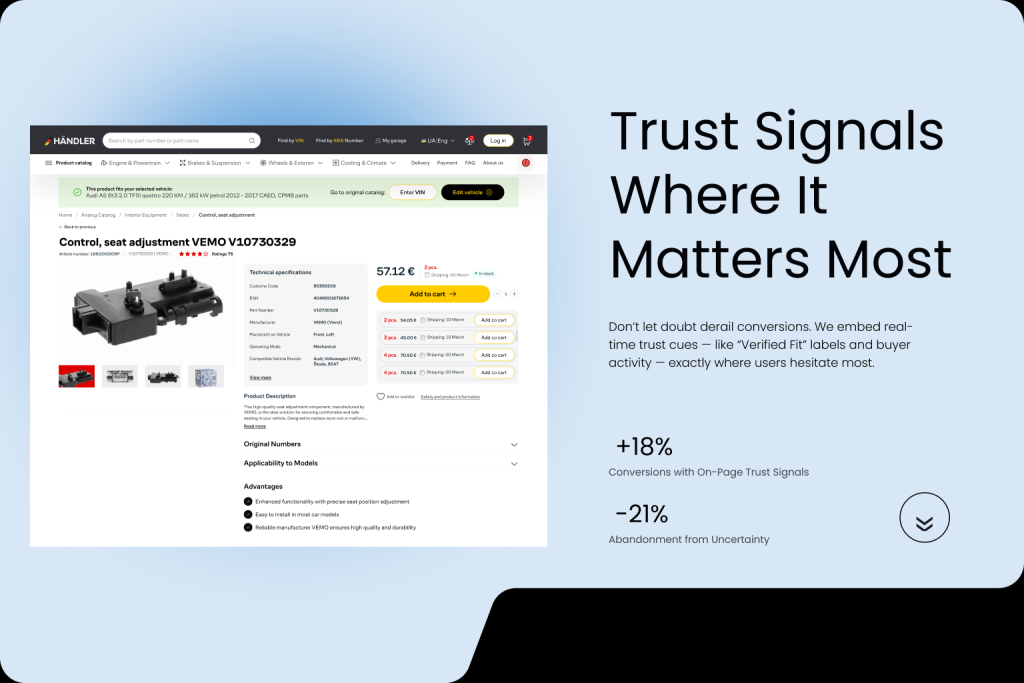Need the best A/B testing tool? This guide reviews the top 10 tools in 2025, covering their features, pricing, and user-friendliness, to help you discover which best A/B testing tool suits your business best.
Introduction to A/B Testing
A/B testing, also known as split testing or bucket testing, is a methodology for comparing two versions of a webpage, app, or marketing strategy to determine which one performs better. This technique involves showing two variants of a page to users at random and using statistical analysis to determine which variation achieves better results for your conversion goals. By using A/B testing tools, businesses can make data-driven decisions, optimize user experience, and boost conversions. For instance, ecommerce websites can use A/B testing to compare different product layouts, while mobile apps can test various navigation menus to improve user engagement. This approach ensures that changes are based on actual user behavior, leading to more effective and efficient optimization strategies.
Key Takeaways
- A/B testing is a key strategy for Conversion Rate Optimization, allowing businesses to make data-driven decisions that enhance user engagement and maximize ROI.
- When selecting an A/B testing tool, look for features like a visual editor, advanced audience targeting, robust statistical analysis, and strong customer support for optimal usability.
- The future of A/B testing will be significantly influenced by AI and machine learning, enabling faster and more accurate testing methods that enhance conversion rates.
Why A/B Testing is Essential for Conversion Rate Optimization
A/B testing plays a crucial role in the realm of conversion rate optimization (CRO) as it empowers companies to compare different versions of a web page or application and determine which one performs better. By conducting A/B tests, marketers can rely on solid evidence when making choices about their strategies, thereby increasing their confidence in these decisions. It is through this method that they not only pinpoint the most effective elements but also gain deeper insights into what truly captures audience interest.
By utilizing A/B testing to detect and rectify aspects of a web page that might be impeding user engagement and influencing customer behavior negatively, businesses may achieve reduced bounce rates. This allows for an improved understanding of how users interact with online content and assists in guiding them along more favorable customer journeys. Understanding visitor behavior through A/B testing can lead to better optimization strategies. Companies have the opportunity to trial test ideas that are low risk on digital platforms while maintaining stable conversion rates.
Instead of focusing solely on driving more traffic towards a website, enhancing ROI could be effectively achieved by optimizing current visitor interactions using A/B testing methods.
Benefits of A/B Testing
The benefits of A/B testing are numerous, including the ability to optimize conversion rates, improve user engagement, and enhance overall user experience. By using A/B testing tools, businesses can create multiple variations of a webpage or app, test them with different user segments, and analyze the results to determine which version performs better. This approach helps to reduce the risk of launching new features or designs that may not resonate with users, and instead, allows businesses to make informed decisions based on real-time performance data. Additionally, A/B testing can be used to test various marketing strategies, such as email campaigns, social media ads, and landing pages, to determine which ones are most effective. By continuously testing and iterating, businesses can stay ahead of the competition and ensure their digital marketing efforts are always optimized for the best possible outcomes.
Key Features to Look for in an A/B Testing Tool
The efficiency of your A/B testing efforts can be greatly enhanced by incorporating several essential elements. One crucial component is the inclusion of a visual editor, which simplifies the process for users to craft numerous variations upon test variations without necessitating any coding expertise. This attribute makes A/B testing tools considerably more approachable and user-friendly for individuals who are not technically inclined.
Equally critical are capabilities that enable advanced audience targeting and intricate customer segmentation. Such features empower you to tailor content specifically for different segments based on demographic data and behavioral insights, thereby ensuring that tests remain pertinent across varied user groups. Possessing the ability to execute an array of experimental methods—including multivariate assessments as well as split URL trials—which incorporate multiple variables, is indispensable for thoroughgoing evaluation through A/B testing, split testing, and server-side experimentation.
A formidable set of statistical analysis functions within these tools should provide options allowing users to apply their chosen statistical methods alongside qualitative instruments. It’s beneficial if there is seamless integration with performance analytics suites along with various other systems or platforms—this facilitates smooth workflow continuity plus effortless sharing of insights across applications.
Lastly but importantly, comes exceptional customer support. Such assistance guarantees that all issues encountered while utilizing these versatile tools can be swiftly addressed—and rectified—by those using them in their everyday operations.
Types of A/B Testing Tools
There are various types of A/B testing tools available, including web optimization platforms, landing page builders, and feature experimentation capabilities. These tools offer a range of features, such as visual editors, multivariate testing, and statistical analysis, to help businesses create and test different versions of their web pages or apps. Some popular A/B testing tools include Google Optimize, VWO, and Optimizely, which offer advanced features like server-side testing, feature flagging, and automatic traffic allocation. When choosing an A/B testing tool, businesses should consider factors like ease of use, scalability, and integration with existing tools, such as Google Analytics. These considerations ensure that the chosen tool can effectively support the business’s testing needs and seamlessly integrate into their existing digital marketing ecosystem.
Top 10 A/B Testing Tools for 2025
In the realm of digital marketing, selecting an appropriate A/B testing tool can lead to a significant transformation. We delve into the foremost top 10 A/B testing tools projected for 2025, presenting distinctive features and abilities that aid in refining web pages and enhancing conversion rates.
The compilation encompasses selections suitable for grand-scale enterprise solutions as well as smaller businesses, providing for a diversity of requirements and financial plans.
Optimizely
Optimizely is acclaimed for its potent web experimentation offerings, enabling users to create and conduct A/B tests as well as multivariate experiments. Focused on serving the needs of enterprise-level clients, Optimizely ensures that it can handle large-scale demands with reliability and efficiency. The platform extends its testing capabilities across mobile environments, supporting both iOS and Android app assessments.
The platform boasts a suite of essential features such as A/B testing methods and basic reporting mechanisms intended to streamline the process of experimentation and customization. It also comes equipped with more sophisticated functionalities including feature experimentation tools along with regularly introduced new elements. Pricing structures are tailored for substantial corporate entities, details of which can be acquired by contacting sales for customized solutions—highlighting bespoke solutions crafted for individual organizational requirements.
By providing an array of instruments required to refine landing pages and bolster user interaction, Optimizely stands out as a comprehensive web optimization resource designed specifically to enhance overall user experience.
VWO
VWO serves as a multifaceted A/B testing instrument that accommodates businesses regardless of scale. It is capable of conducting both A/B tests and multivariate examinations, positioning it as an all-encompassing platform for web-based experimentation. An exceptional aspect of VWO is its integrated heatmap functionality, which provides valuable perspectives on how users engage with your website. This functionality helps businesses understand how customers interact with their websites, allowing for better optimization of page layouts and content.
VWO presents straightforward segmentation tools to facilitate the provision of personalized offers, thereby improving user engagement and experience. The combination of a user-friendly design and powerful capabilities renders VWO a prime option for enterprises seeking to enhance their digital marketing strategies through optimization.
AB Tasty
AB Tasty offers a robust array of A/B testing instruments, capabilities for managing features, and customization choices that aim to improve conversion metrics. Its notable advantage is the ability to connect with Contentsquare, which elevates the understanding of user behavior and refines results obtained from A/B tests.
By experimenting with components focused on conversions, such as widgets suggesting products, AB Tasty propels personalized interactions with users and increases their involvement. The cost for these services can be provided upon inquiry, ensuring that solutions are customized according to the requirements of each client.
Unbounce
Unbounce, renowned for its capabilities as a landing page builder, includes integrated A/B testing tools designed specifically to refine and enhance landing pages. Unbounce excels in landing page testing to optimize conversion rates. The platform enables users to quickly establish A/B tests within mere minutes and offers the Smart Traffic feature that intelligently routes visitors to the version of the page that performs best.
With pricing tiers extending from $112 up to $649 monthly, Unbounce’s plans are structured to accommodate businesses of different scopes and requirements. It stands out for its user-friendly nature, especially beneficial for non-technical users who wish to boost engagement levels and optimize experiences for their users.
Crazy Egg
Famed for its pioneering heatmaps and session recordings, Crazy Egg excels at pinpointing areas on web pages that can be optimized. It provides qualitative tools like heatmaps to understand user behavior. It’s exceptionally fitting for small businesses with marketers, designers, and product teams who prioritize a user-centric approach.
Starting from an accessible price point of just $24 monthly for the basic plans, Crazy Egg offers an economical solution. It features a straightforward interface that streamlines both carrying out A/B tests and interpreting their results. Crazy Egg allows businesses to test different variations of web pages to optimize user engagement.
Kameleoon
Kameleoon is tailored for large-scale companies, providing sophisticated A/B testing, feature experimentation, and artificial intelligence-driven customization. It is a comprehensive experimentation platform frequently utilized by sectors such as healthcare, financial services, and insurance.
The platform boasts an integrated system that combines targeting with analytics and activation capabilities. This allows for extensive experimentation on various website components such as layouts and content to guarantee alignment across all stakeholders. Kameleoon helps optimize user experiences through extensive experimentation. Kameleoon offers strong integration capabilities with ecommerce platforms including Shopify to augment its effectiveness.
Dynamic Yield
Dynamic Yield offers key features such as omnichannel testing, predictive analytics, and segmentation of user interactions. This makes it perfectly suited for companies in search of sophisticated personalization capabilities and A/B testing functions.
The platform’s advanced omnichannel personalization solutions enhance its A/B testing tools, positioning Dynamic Yield as an all-inclusive option for boosting user engagement through various channels.
Apptimize
Apptimize specializes in enhancing mobile app experiences through comprehensive A/B testing and effective feature management. Its notable capabilities include the utilization of feature flags, a full-control visual editor to craft experiments, along with robust A/B testing features.
This platform facilitates experimentation across both mobile and web platforms, assists in optimizing cross-platform user engagement, and manages the deployment of new features. Apptimize also supports optimization for mobile web platforms, showcasing features like heatmaps and session recordings to enhance user interactions. Apptimize invites businesses of diverse scales to explore their services by providing a 30-day free trial and tailoring pricing options according to individual business needs.
Convert
Convert provides a solution for individuals without technical expertise who have intricate requirements by offering an intuitive drag-and-drop interface along with a sophisticated code editor. The platform’s visual editor enables the creation of various tests, including A/B, multivariate, multipage, and split tests — all essential tools for enhancing conversion rates. Convert supports multivariate tests to evaluate multiple variables simultaneously.
Starting at $199 monthly, Convert presents a cost-effective plan for companies looking to enhance their conversions and refine their digital marketing tactics. Convert allows running multiple experiments on the same page to optimize user engagement.
Google Optimize Alternatives
As Google Optimize approaches its end-of-life on September 30, 2023, companies are in pursuit of reliable substitutes. Omniconvert presents a robust optimization platform that encompasses A/B testing, personalization, surveying capabilities, and client segmentation.
For those looking to conduct swift experiments while maintaining measured deployment strategies, LaunchDarkly offers the ability for real-time feature flagging. Additional prominent alternatives such as Oracle Maxymiser, Statsig, and Zoho PageSense stand out by providing distinctive functionalities tailored to diverse business requirements.
A/B Testing for Specific Industries
Ecommerce
In the ecommerce industry, A/B testing can be used to optimize conversion rates, improve user engagement, and enhance overall user experience. Ecommerce websites can use A/B testing to compare different product layouts, test various calls-to-action, and analyze the results to determine which version performs better. For example, an ecommerce website can use A/B testing to compare a product page with a prominent “Buy Now” button versus a page with a more subtle “Add to Cart” button. By using A/B testing tools, ecommerce businesses can gain valuable insights into customer behavior, identify areas for improvement, and make data-driven decisions to optimize their website and improve sales. Additionally, A/B testing can be used to test different pricing strategies, product recommendations, and checkout processes to further optimize the customer journey. This continuous optimization process helps ecommerce businesses stay competitive and ensure their online store is always performing at its best.
How to Choose the Right A/B Testing Tool for Your Business
When choosing an appropriate A/B testing tool, it’s important to thoroughly assess your specific requirements for conducting tests. Look for transparent and straightforward pricing structures that do not contain undisclosed charges and ensure the tool can scale with your business as it expands. Consider various payment options including monthly subscription plans, pay-as-you-go alternatives, or complimentary trial periods to suit varying financial capacities. Additionally, selecting A/B testing tools from reputable software vendors is crucial to ensure comprehensive customer support and access to valuable resources.
It is also crucial to select a user-friendly A/B testing tool that caters to users without technical backgrounds. The ability of the tool to integrate effortlessly with other existing tools in use is necessary for smooth workflow and efficient data exchange. Comparing other tools to understand their features, pricing, and integration capabilities will enable you to make an informed decision. Possessing the requisite technical expertise will enhance the effective deployment and use of the chosen A/B testing instrument.
Best Practices for Effective A/B Testing
Begin A/B testing by formulating a concise hypothesis centered on goals related to conversions. To prevent skewness, randomly distribute subjects across both experimental variations and the control groups. Define key performance indicators (KPIs) for precise measurement and aim for a confidence level of 95% to affirm statistical significance in the analysis of your A/B tests.
Scheduling A/B tests at optimal times, steering clear of high-activity business intervals, is critical to enhancing the reliability of outcomes. Adherence to these recommended procedures guarantees that your A/B tests produce significant data that can be effectively utilized for decision-making purposes.
Integrating A/B Testing Tools with Other Platforms
Incorporating A/B testing tools into additional platforms amplifies the efficacy of digital marketing campaigns by providing a consolidated perspective of the entire customer journey. Integrating a web optimization platform can further enhance digital marketing campaigns by offering functionalities such as A/B testing, heatmaps, and real-time data. By synchronizing marketing analytics tools with CRM systems in real time, you can achieve current and relevant insights. To maintain an all-encompassing understanding of your audience, it’s essential to meticulously monitor every interaction customers have.
The robust reporting capabilities offered by these integrated systems allow for the conversion of analytics into actionable insights based on existing data. An experimentation platform can provide comprehensive insights for better decision-making. It’s vital to ensure that any new A/B testing tool is compatible with pre-existing systems to prevent future complications and facilitate seamless integration.
Employing A/B testing tools together with various other platforms simplifies the process of handling data while also yielding more precise and accurate insights from your analysis.
Analyzing and Interpreting A/B Test Results
Statistical significance is crucial for determining if test results are reliable or merely coincidental. It is vital to assess the uplift, which reflects the performance disparity between a variant and a control group, in order to grasp their comparative efficacy accurately. To prevent reaching incorrect conclusions, it’s important to consider secondary metrics as well as primary ones.
Delving into the data by specific audience segments can uncover behaviors and more profound insights that might be concealed within broader aggregated statistics. Ignoring external elements such as market trends could lead to erroneous interpretations of A/B test outcomes. Utilizing a Bayesian method may provide more trustworthy insights when dealing with smaller sample sizes.
Common Pitfalls to Avoid in A/B Testing
It is essential to be mindful of typical errors when employing A/B testing, given its effectiveness. Relying on conventional methods for determining statistical significance might lead to insufficient sample sizes that do not yield decisive outcomes. During the process of A/B testing, unforeseen modifications could impact rankings in search engines. Thus, it’s vital to maintain SEO considerations.
A/B testing provides important qualitative data that can enhance strategic planning irrespective of the results achieved. To ensure successful results from A/B tests, having a robust approach to data analysis is critical.
Real-World Examples of Successful A/B Tests
Examples from real-world A/B tests provide crucial insights into successful tactics. Hubspot, for instance, saw a 6.8% rise in lead page signups after introducing a ‘Limited time’ badge to their offering. L’Axelle achieved an impressive 93% increase in conversions by altering their landing page headline to one that prompted action. Such instances highlight the power of minor modifications in yielding substantial outcomes.
The addition of a progress bar on UNICEF’s donation page led to an astounding 51% surge in contributions, showcasing how visual cues can enhance user engagement. Similarly, Beckett Simonon experienced a sales boost of 5% by weaving storytelling into their website content. These strategies illustrate the effectiveness of carefully executed A/B tests in elevating conversions and profits across diverse industries.
Future Trends in A/B Testing
AI and machine learning are set to transform A/B testing profoundly. Dynamic is dynamic. Yield employs predictive algorithms that leverage machine learning to refine the results of A/B tests, thereby boosting business returns on investment. By methodically evaluating data from these tests and uncovering trends, these advanced technologies aid in shaping strategic decisions.
Incorporating AI and machine learning into A/B testing promises a paradigm shift in how businesses tackle conversion optimization by expediting test procedures while enhancing precision. With ongoing advancements in these areas, it’s anticipated that they will furnish more streamlined and potent approaches to testing that cultivate superior user experiences alongside increased conversion rates.
Summary
In essence, A/B testing serves as a critical component for enhancing conversion rates through data-informed decisions that augment user interaction and elevate the number of conversions. Identifying and utilizing an A/B testing tool with the right capabilities is crucial in refining web pages and fortifying digital marketing approaches.
As AI and machine learning evolve, they promise to Enhance the effectiveness of A/B testing tools. Keeping abreast with cutting-edge developments and superior methodologies guarantees that your A/B tests produce substantial results that can be acted upon. Leveraging the strength of an effective A/B testing strategy is key to catalyzing growth within your online marketing efforts.
Frequently Asked Questions
What is A/B testing and why is it important for conversion rate optimization?
A/B testing serves as a critical tool for contrasting two different versions of an app or webpage, aimed at identifying which performs superiorly. This technique is essential in the realm of conversion rate optimization because it empowers organizations to make choices based on data-driven insights, thereby improving user engagement and elevating conversion rates.
What are the key features to look for in an A/B testing tool?
When selecting an A/B testing tool, prioritize a visual editor, advanced audience targeting, statistical analysis capabilities, integration options, and strong customer support.
These features are crucial for effective testing and optimization.
How do I choose the right A/B testing tool for my business?
To choose the right A/B testing tool for your business, prioritize your testing needs, evaluate pricing, assess user-friendliness, and ensure integration capabilities and strong customer support align with your requirements.
This focused approach will help you make an informed decision.
What are some common pitfalls to avoid in A/B testing?
It’s crucial to avoid inadequate sample sizes, unexpected SEO changes, and misinterpreting data in A/B testing.
Always establish a clear hypothesis and a strategy for analyzing your results to ensure reliable outcomes.
How will AI and machine learning impact the future of A/B testing?
AI and machine learning will significantly enhance A/B testing by enabling faster and more accurate analysis of data, leading to more efficient and effective testing methods.
This will ultimately improve decision-making and optimize outcomes in various applications.




